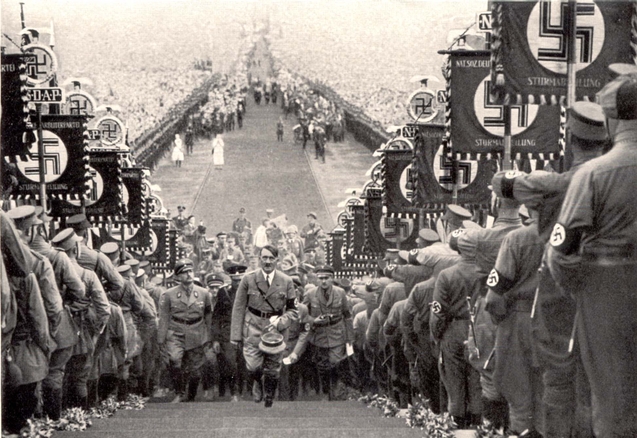The Rise of Hitler
Part 1 of 1: Examine the timeline below of the major events of Hitler’s life and his rise to power. Then write a 3 sentence summary of how Hitler came to power in Germany.
- Hitler fought in WW1. He was a dispatch runner. He was wounded twice and survived a gas attack. For his service, he earned First and Second Class Iron Cross medals.
- The Treaty of Versailles humiliated Hitler. He also felt Germany was being corrupted by Jews and Communists.
- In 1919, he joined the German Workers Party, and by 1921, he became its self- imposed Chairman. He renamed the Party as the National Socialist German Workers Party (Nazi). The Nazi had 3,000 members.
- Hitler introduced his 25-point program that included the Final Solution for Jews (exclusion from society, ghettos, annihilate).
- In 1923, Hitler tried to stage a coup to overthrow the German government. Called the Beer Hall Putsch, the coup ended with 19 dead, many wounded and Hitler jailed for five years. The attempted coup was not a failure because it raised the profile of a political nobody.
- Hitler became more politically active. By 1933, he had been elected Chancellor of Germany with a majority of the seats in the German Parliament. NOTE: 63% of Germans did not vote for Hitler. They failed to vote with a unified voice against the Nazi.
- Almost immediately, Hitler enacted the Enabling Law. The law gave the Government the power for four years to enact laws without the input of the Parliament and deviate from the German Constitution.
- One week later, the Nazi passed the Temporary Law for the Coordination of the States and the Reich. Under this law, states were required to conform to the German Parliament. Hitler installed a Nazi Party member as the leader of each state.
- Police forces were combined to form the SS and the Gestapo. Soon afterwards, Germany became a police state.
- In 1933, Germany withdrew from the League of Nations.
- In 1934, Hitler began a campaign to purge Germany of his political foes.
- In 1934, the German Reich President died. Hitler abolished the title and declared himself Fuhrer. All troops were required to swear an oath of allegiance to Hitler…not to the country.
- After the “invited conquest of Austria”, Hitler looked at the Sudentenland of Czechoslovakia. Hitler noted that many people of German descent lived in this area, and that they wanted to be part of Germany. The Czechs were ready to fight, but the world was not. British Prime Minister Neville Chamberlain and French Premier Dadodian agreed to the German occupation of Sudentenland at the Munich Conference. By March 1939, Germany controlled, by force, all of Czechoslovakia.
- In August 1939, Germany signed a Non-Aggression Pact with the Soviet Union. In the pact, these two nations would not fight each other and they would divide Poland. Hitler could now concentrate his political efforts on his western border.
- In September 1939, Hitler demanded the Polish Corridor awarded to Poland in the Treaty of Versailles be returned to Germany. Poland refused.
